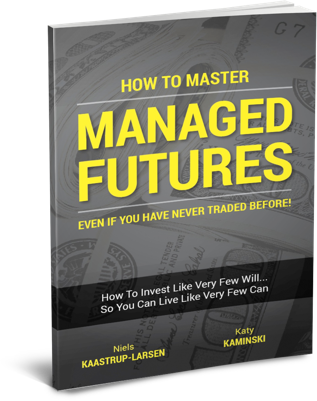If you would like to hear the full episode then you can just click here

Katy: I have a question too, one of the biggest challenges we’ve had in the industry has been return dispersion for investors too. It’s that you have one fund up, another fund down, it seems that there’s a lot of difference in terms of how performance has not been very consistent across managers in the space and that creates a lot of confusion for the investors.
How has your experience been with this? Have you encountered… Do you have some thoughts about how DUNN sees that and how you have fared in this sort of change in the industry, and what do you think drives it?
There’s always a sweet spot for your period of time you’re looking back over.
—Fname LnameMarty: Gee whiz, Katy, you’re the expert in this area. You’re the one that should know these answers (laughter). This is my opinion, which you can tell me whether you agree with my opinion or not.
Katy: I want your opinion.
Marty: I think it really has to do with time periods that people are looking at. There’s always a sweet spot for your period of time you’re looking back over. I think one thing that has worked well for DUNN is that we don’t put any restrictions on what’s available to the program from a time constraint. It can go as short as a week and as long as four or five years if it chooses that.
Now, the parameter selection process is automated, it happens weekly, but it doesn’t matter that it happens. It’s not imperative that it happens each week. We can go eighteen months without any real difference in return, so it’s not sensitive to the parameters.
I think it’s important that you allow the system to evolve between shorter time periods and longer time periods given whatever the investment environment is. That’s the only reason I can see why… Well, that’s one of the many reasons why, I think, we’ve been able to manage this environment well. Between the ARP, between the uncorrelated revenue streams that we have, and the adaptive nature of our system, we have an exit strategy that has been implemented over the last five to seven years. All these things have made us better.
Katy: Yeah, I mean it’s been a very… If you think about it, the reason that I’m interested is that you’ve done very well for your investors over the last few years and it has been very challenging. Quantitative easing, very low trends…
Marty: It’s been one of the most difficult environments that I have ever seen in what we do. I thought this was going to be easy, and you look at the post-financial crisis and it has just been a hard road for trend following systematic managers. What’s happened is the central banks have created this environment where everything is correlated across all the markets. So, in reality, I ask myself, “Do we have diversity?”

What is diversity? So, people are investing in their stock portfolios. They go to a mutual fund, “Oh, we’re a diverse mutual fund. We have a hundred and fifty holdings. Nobody has more than two percent of the AUM, all these stock names, pretty diverse, right? I would proposition no. If all those stocks are highly correlated aren’t you truly only invested in one thing?
That’s the same thing that happens in the managed futures space when all the markets become correlated. It’s a lot harder for our markets to become correlated because it’s the softs, it’s the energies, it’s the metals, it’s the currencies, it’s the interest rates, it’s bonds, it’s equities, across all geographical areas.
But, after the financial crisis and the central banks were all working in tandem, yeah, those markets became very highly correlated. That is the most difficult time for us to make money is high correlation, low volatility. There are no trends. Everything is trading sideways. Because of low volatility, people tend to want to put more positions on because they’ve got to get to their risk targets.
This is what started our research on the Adaptive Risk Portfolio because that doesn’t make sense to do that. So, we’ve now incorporated that into our model so that we don’t do things that don’t make sense.
The thing that’s the most encouraging that we’ve seen in the last quarter of the year and is exciting to me is the correlation matrix is broken down. Everything is starting to break apart; you’re starting to see European bonds move different than US bonds, Asia moves differently than the rest of the world. These give us opportunities to make money.
All we need are opportunities, and the winners are always going to outweigh… The winners are big, the losers are small, that’s the whole point of trend following.
All we need are opportunities, and the winners are always going to outweigh…
—Marty BerginNiels: I think there are two really interesting observations here. One is, and I don’t know that people really know that, but since 1990 when the BTOP50 Index was started to be computed, there are only seven years where it’s down, but six of those seven years has been since 2009 when quantitative easing started. So, there’s a very clear correlation to exactly your point. Of course, since Katy is here, the queen of divergent and convergent strategy, I’d love to hear your opinion as well to what Marty says about what we, as trend followers, really need.
Katy: Well, I mean, Marty is exactly right is that high correlation low vol is a challenging environment, but we can also add the fact that interest rates have been very low too. So, we haven’t had the carry moving directionally a lot of assets.
So, he’s exactly right in that if you’re focusing on being adaptive to those environments and adjusting your risk and implementing that into your process that is really trying to think proactively in how you can handle those different types of environments without blindly saying, “This is a model that worked,let’s execute it.” So, it sounds like that’s the direction you guys went. In that you were looking at adaptive risk and better thinking about correlation…
Marty: You hit on it. I hate to admit it, and I think anybody in our space hates to admit it, but a lot of the returns, back in the ‘70s and ‘80s were driven off of interest rates. Let’s face it.
Katy: It was up to eighteen percent.
Marty: When sixty percent of your assets are held in cash and are earning interest, that could be quite a nice little hurdle. Now, I will tell you, from DUNN’s perspective; we’ve always excluded that in any of our model development. So, we’re OK working in a zero interest rate environment.

All the backtesting that we do, and the out of sample testing that we do and the development of our systems are assuming, basically, a zero rate environment. We don’t plan for any money to be made on our excess cash.
That doesn’t mean we don’t look at… Clearly, futures are more dynamic in the interest rate environment of the older days. The other adage is that managed futures can’t make money in a rising interest rate environment. That just doesn’t make any sense to me. I’ve heard people that will look at me and say, “Well, you’re crazy. Doesn’t it make sense to you? It’s obvious.”
Well, no, because futures prices build interest rate into it. It’s a very simple concept. It’s saying, “In the future, the bond price is going to go up or down by this much based on the projected interest rates.” Either the interest rates move the way you expect it or they don’t. If they don’t, then the price of the futures moves differently than what was projected.
People try to make it too complicated sometimes, and start doing this evaluation of interest rates and how you should be, “Oh interest rates are going up, you should be short bonds.” Well, no, if interest rates don’t go up as fast as you think they’re going to go up then you should be long bonds because that’s the right trade.
Our system is still holding. All the European bonds are still long. We’ve gotten short the U.S. bonds. The other thing that we’ve seen in looking at our simulations and our out of sample data, in our live real trading is that we never take positions on the short side as strong as the long side positions. It just doesn’t happen. I think it’s because people’s perceptions about interest rate are off kilter. So, I think people always think interest rates are going to go up faster than they do. They never go up as fast as people think.
Katy: They’re afraid they’re going to go up faster.
Niels: I think, actually also, when you do research, and if you look at certainly the simpler trend following systems, what you do realize, and this could be tied into the thirty year interest rate cycle that we’ve had, but when you do that, actually, eighty-five or ninety percent of the returns come from long sided trades, whether that’s because it’s easier to capture because short sided trades can turn very quickly, this and that.
But, I agree with Marty that there shouldn’t be any concern that there’s a particular environment where trend following doesn’t work unless there are no trends.
Marty: Right. So, to me it makes perfect sense why most of the trends are on the long side. It’s inflation. The economy is always growing, prices are always growing, and everything is going up. It just doesn’t go up in a straight line
Download "Trend Following" Ebook








